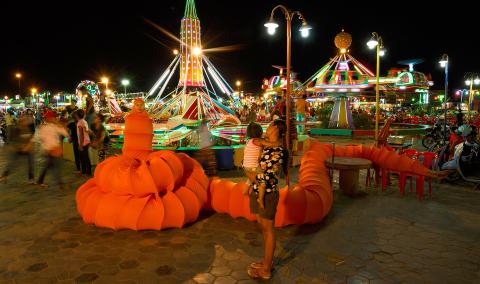Haegue Yang
APT8
Born 1971, Seoul, South Korea
Lives and works in Seoul and Berlin, Germany
Referring to modernist art history, literature, and social and political events, Haegue Yang transforms spaces through light, colour, objects and movement to ensure a constant shift in perception and experience. Yang’s work alludes to the relationship between cultures and language as experienced through translation, migration and diaspora, as well as the formal properties of specific materials.

Sol LeWitt Upside Down – Open Modular Cubes (Small), Expanded 958 Times 2015 consists of 1012 white Venetian blinds, arranged into grids and suspended from the ceiling in an inverted and expanded rendition of the ‘open modular cube’ structures, signature works of American conceptual artist Sol LeWitt. First exhibited in New York in 1966, LeWitt’s structures used the reductive form of an open cube as their base unit, which was repeated in stepped and gridded arrangements to produce geometrical objects. LeWitt’s artworks were at once rigorous in construction and elaborate in appearance.
Yang appropriates, up-scales and upturns this classic motif. Where LeWitt’s cubes were solid-edged, open-sided and made-to-order from industrial producers, Yang’s are impressionistic, created by arrangements of ready-made household blinds whose overlapping slats may be read as either open or closed, depending on the position of the viewer. Through the use of domestic materials, Yang moves LeWitt’s aesthetic propositions into the world of everyday experience. She foregrounds shifts involving mass, volume, space and light, and the degree to which, like the diasporic experience, such qualities are constantly under construction.

Haegue Yang / South Korea/Germany b.1971 / Sol LeWitt Upside Down – Open Modular Cubes (Small), Expanded 958 Times 2015 / Commissioned for APT8. Purchased 2015 with funds from Tim Fairfax, AC, through the QAGOMA Foundation / © Heague Yang / Photograph: Natasha Harth, QAGOMA
